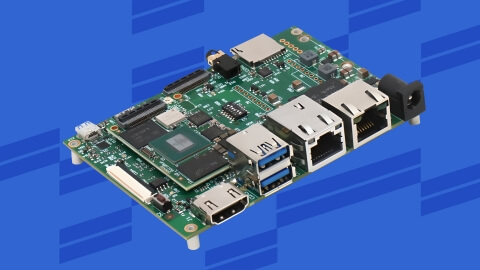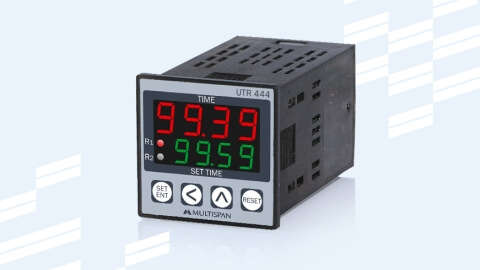IoT-connected devices have a wide range of uses and applications in consumer electronics, energy, agritech, healthcare, and transportation, focusing on cloud-based systems and sensor technology.
IoT devices capture and transfer data within a single network and can be used for smart systems like heat measurement, security systems, smoke detection, and other business or manufacturing needs.
Remote IoT device management enables stable equipment performance, predictive maintenance, and damage or danger prevention.
This article investigates the benefits and use cases of remote IoT network monitoring. Keep reading to learn how to manage your devices using a multifunctional IoT device management system.
How does an IoT device network operate?
IoT devices have integrated sensors responsible for performing specific features like heat measurement, smoke detection, etc., and firmware that allows collecting and transmitting this information to the IoT management system dashboard via the internet gateway with the internet.
Sensors are commonly connected to the device via various wireless technologies that allow the hub or router to collect information, preprocess it, and show results about the current device state to end users.
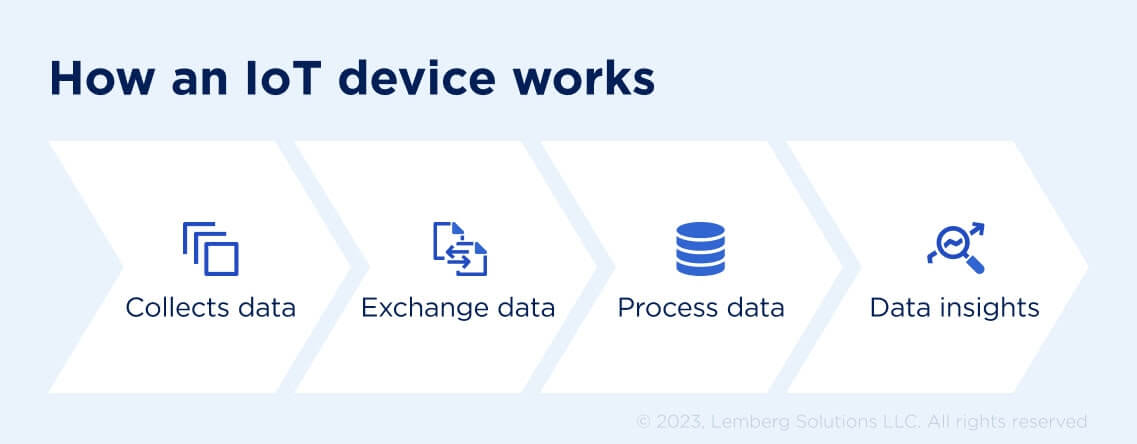
Collects data
IoT devices collect data about the environment where the device is placed. It can be environment temperature, real-time video/audio streaming, noise monitoring, etc.
Exchanges data
The IoT sensor collects data on a device and sends it to the cloud or local server for further processing and analysis.
Processes data
Data processing allows end users to get notified about the device environment and its operability or send alerts about malfunctions.
Provides data insights
Processed and analyzed data allows you to make informed decisions and global business changes.
Benefits of remote IoT network management for industries
The Internet of Things has found lots of uses and applications in agritech, automotive, energy, healthcare, transportation, and other industries. We researched the benefits this technology brings to different business directions and how IoT devices transform their internal operations.
Agritech
Agritech is one of the most rapidly growing and digitized industries where the usage of IoT-connected devices is widely spread. They are used for crop monitoring and analysis (including irrigation and soil probing), livestock monitoring (animal weight, temperature, etc.), staff management, and other purposes.
IoT-enabled devices with sensors and modules allow you to keep up to date with field or farm areas, take some actions remotely based on the received data from sensors, and ensure the environment's safety, including device damage prevention.
Transportation & Logistics
By creating a network of IoT sensors, modules, and devices, remote vehicle management becomes available, easy, and safe. IoT networks are common for transportation companies that expect proper remote fleet management. These can be sensors to track vehicle locations, working hours, and destinations to propose safer and faster routes and plan the whole trip with potential stops.
IoT devices with sensors can also be used for driver and vehicle protection, like cameras with real-time monitoring, smart locks, GPS tracking, etc. Find out more about our cooperation with the KONVOI company that produces and installs smart truck security solutions, where we helped ensure the proper and real-time sensor data collection and transfer to the cloud.
Energy
IoT-connected devices are irreplaceable for the energy industry, especially if we consider windmills and power plants' remote monitoring management. Integrated sensors provide smart energy metering to measure resources like electricity, gas, and water consumption, predict and prevent equipment malfunctions, and manage battery conditions and energy consumption. However, energy monitoring solutions are also useful for energy companies, manufacturers, and regular consumers.
Here, we described how we collaborated with powerfox, a German-based company that helps consumers monitor and optimize their energy consumption using special poweropti devices and mobile apps on their smartphones.
Healthcare
Medical IoT devices with embedded systems that provide remote patient monitoring have become a real breakthrough in the healthcare industry. Hospitals and other medical facilities offer their patients smart devices like watches, bracelets, or monitoring gadgets that collect real-time health information and send it to the hospital information system.
However, tech advances keep evolving, providing smart surgical devices, cough recognition, medical images, and motion analysis with IoT technology. You can also read more about an IoT telemedicine platform for cough sound recognition we built for Carepath.
The list of IoT applications for businesses is more comprehensive than the examples mentioned above. If you want to unlock the potential of IoT for your company's needs, schedule a consultation with our IoT experts to discuss your tech challenges to manage IoT device remotely and find ways to resolve them effectively with Lemberg Solutions.
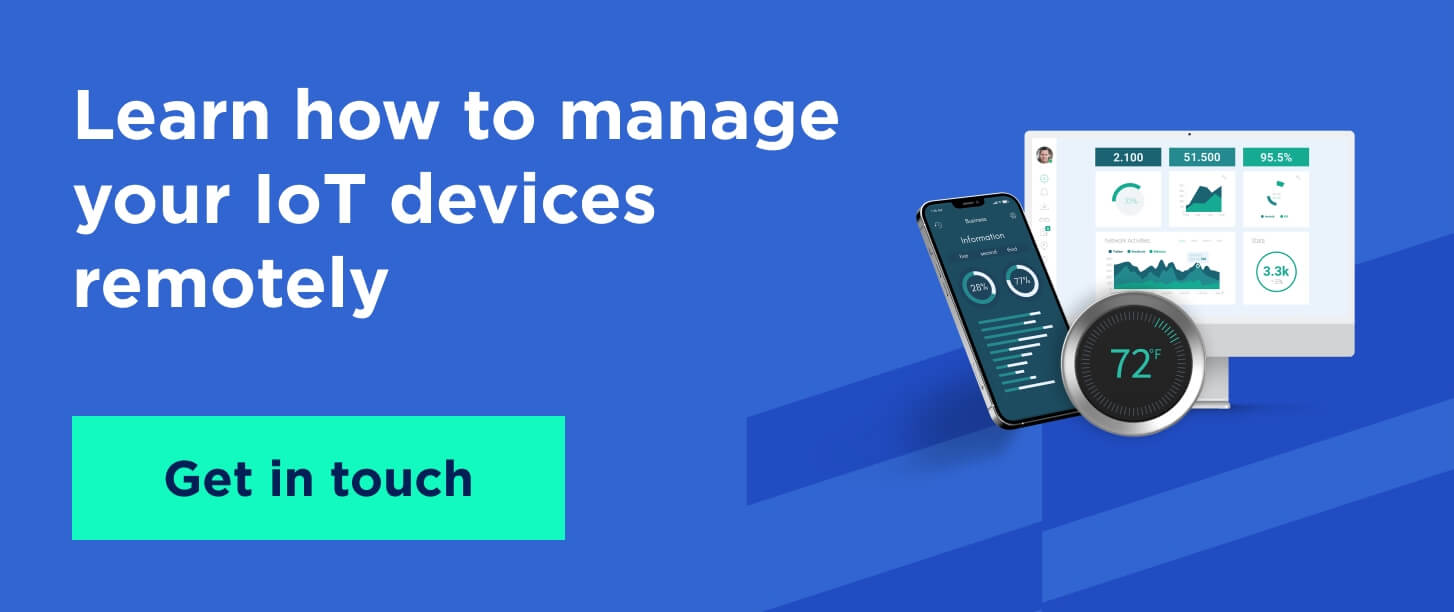
How to manage IoT devices remotely?
Companies with large-scale and evolving IoT networks require various tools and options to manage IoT infrastructure remotely. That's where the IoT device management system comes in handy, providing remote device management, data tracking and storing, granting data access permission, and other functions needed to cover proper IoT network monitoring. Its architecture ultimately depends on the goals you want to reach, whether it is a web or mobile application, cloud-based or on-premise solution.
IoT devices are integrated with embedded software or firmware and sensors, where sensors collect particular information about the environment or device condition, store it, and send it to the cloud using firmware functionality. The IoT device management system helps visualize the collected data and its type depending on the IoT device remote task within your network.
In addition, developing an IoT device management app ensures the following:
- IoT infrastructure scalability — you scale the number of IoT-connected devices but still can efficiently manage their onboarding and performance remotely
- Gateways and cloud connection — you keep track of the data transferring process to the cloud
- Restricted data access — you can monitor users' data permissions, their active logs, and data-related activities, restricting access in case of unusual activity.
Further, we would like to dive deeper into the features an IoT device management platform provides, making remote IoT device management more accessible and more efficient. The functionality can be customized, considering your ongoing business challenges, IoT network scale, and planned growth points.
IoT device management solutions help you set up the whole management process - from connecting new devices enabled with AI or ML algorithms to getting valuable business data insights following the best data science practices.
Further, we outline the main steps in remote IoT device management using a business-tailored IoT management platform.
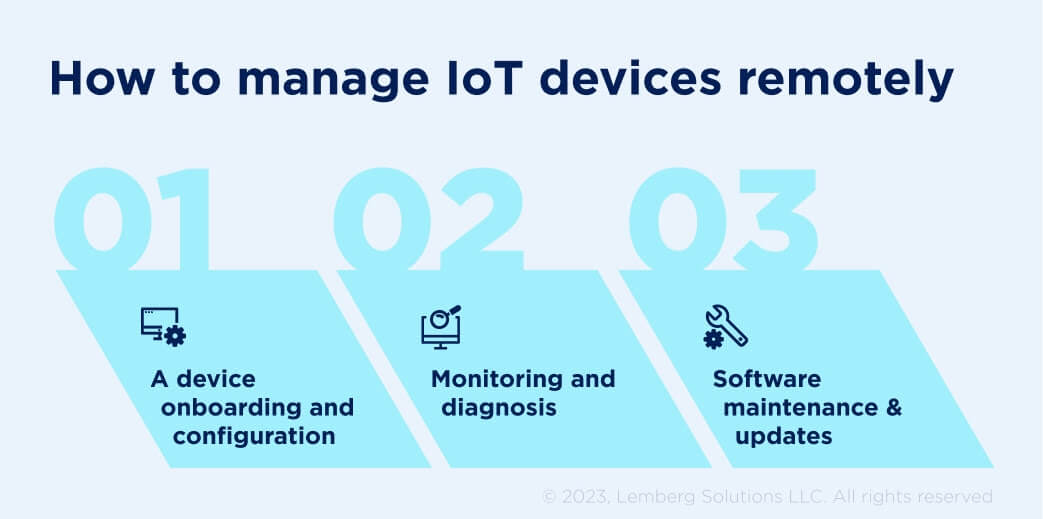
1. Device onboarding and configuration
Adding a new IoT device to your network requires thorough attention to device configuration, especially related to data security. Each device must be provisioned with security credentials, network connectivity, and specific features identifying the device's function within the whole network.
2. Monitoring and diagnosis
A centralized IoT network allows remote device monitoring and diagnosis as, in most cases, devices don't have enough resources to cover diagnostics. This option provides the capability to keep track of device performance to troubleshoot urgent errors quickly and effectively, ensuring stable IoT network operation.
3. Software maintenance & updates
The key to stable device performance is regular software (firmware) updates, which help resolve security vulnerabilities and maintain the device remotely. Based on our extensive experience in IoT expertise, we ensure that OTA (Over-the-Air) update functionality is necessary for firmware development to release remote device updates on time and smoothly.
Challenges you may encounter with remote IoT device management
Setting up the IoT network from scratch or scaling the existing one might bring various challenges and risks you and your tech partner should consider in advance. The probability of system errors grows simultaneously with your IoT network — the more devices need to be onboarded and provisioned, the more complicated management gets. Nevertheless, a reliable IoT tech partner can easily prevent these and other potential vulnerabilities.
Secure data collection and transfer
IoT devices collect and transfer vast volumes of data daily. Storing this data on local servers provides many risks of data breaches, leakage, unauthorized access, and loss, eliminating the ability to get information about the environment and device conditions and valuable insights for business decisions.
Our cloud experts will help set up the cloud environment for an IoT network with Azure, AWS, or Google Cloud services, considering the best data security practices and industry compliance and requirements. You can also learn more about our cloud expertise by following this link.
Communication between devices
IoT devices have a range of security vulnerabilities related to unauthorized access, data breaches, and malware attacks. The more your IoT network scales, the more complicated the security and privacy management gets. We offer to set up standardized communication protocols and frameworks to provide a merged IoT network where devices are connected and transfer data between each other as expected.
Lack of IoT network support
To reach your business goals by launching and managing the IoT devices network, you should define core business requirements and build a precise implementation and post-launch management plan.
At Lemberg Solutions, we follow the best SDLC practices with the defined development plan, from discovery to research, document your requirements, and outline the project scope, goals, timeline, and budget. This approach guarantees that the remote IoT management system and IoT device network correspond to your needs and expectations. You can find more details about our IoT development services and experience through the link.
Summing up
If you want to take maximum advantage of the Internet of Things, it is pivotal to set up the proper environment for the devices, enabling efficient remote management and getting valuable business insights.
Our specialists will help you research and define the core requirements for your IoT remote management tool. We will pick the practical solutions to resolve current tech issues and cover your business needs, considering industry specifics and compliance, whether you produce IoT systems for your consumers or want to remotely manage manufacturing equipment on a business level.
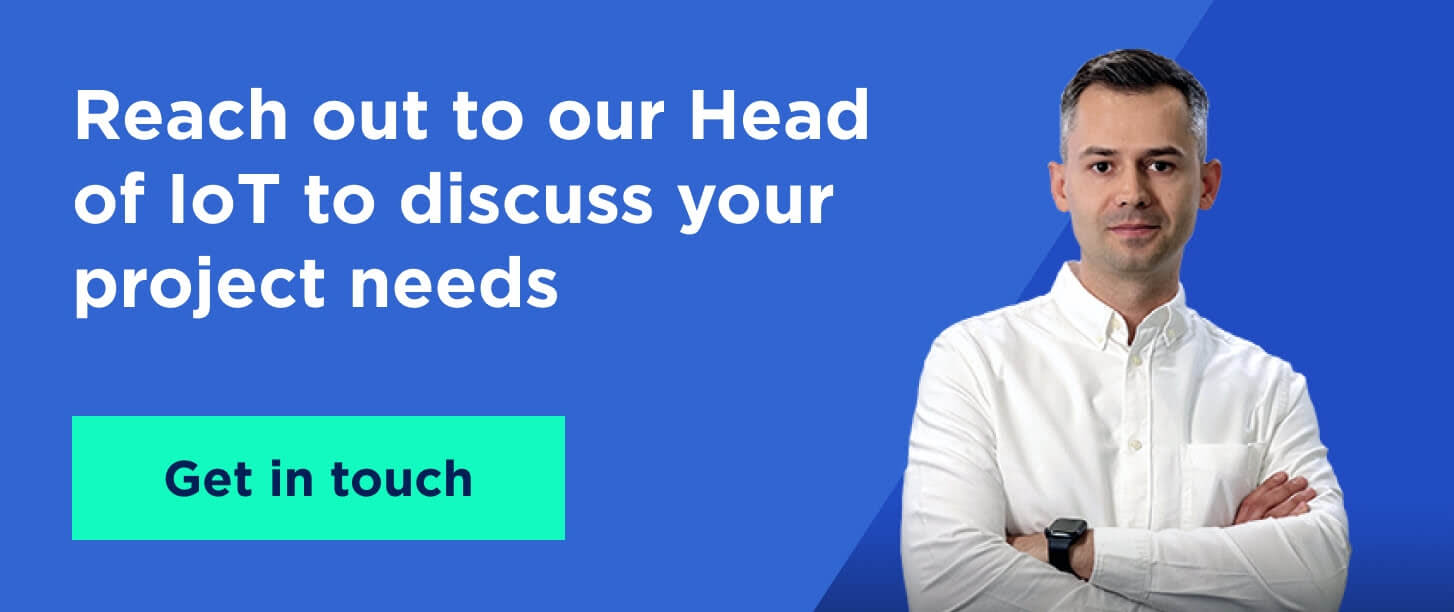
FAQ
How can you ensure remote management of IoT devices?
The control of IoT devices remotely is easy if you have an easy-to-navitage and multifunctional IoT device management system. It provides an IoT data dashboard collection from IoT-connected devices, connects and configures new devices, monitors device conditions, and helps perform timely firmware updates. So, can we operate IoT devices remotely? — Yes, we can.
Why choose LS for developing an IoT device management system?
We have over 16 years of experience in IoT projects in various industries, including energy, consumer electronics, healthcare, transportation, and logistics. Our team always finds a custom approach to each project, from discovery or auditing the existing IoT apps to offering effective solutions. Feel free to reach out to our Head of IoT, Slavic Voitovych, and discuss your ongoing tech challenges with remote IoT device control.


